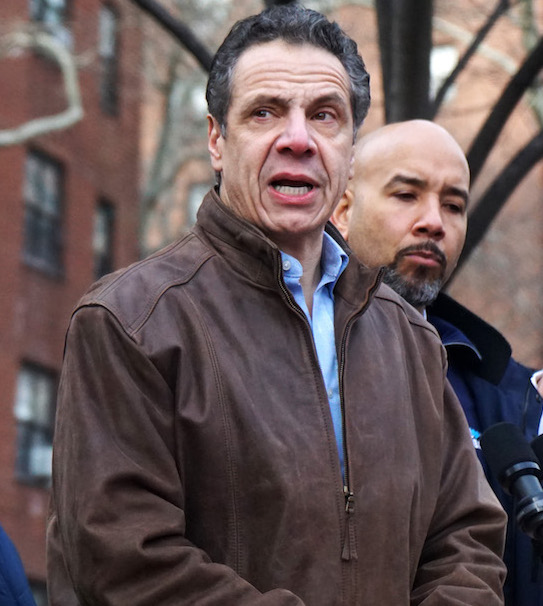
But Cuomo is mum about NYCHA’s commitment to local hiring
While touring the Jackson Houses in Melrose on March 12, New York State Governor Andrew Cuomo was struck by the “filth,” peeling paint and evidence of cockroaches he saw.
“I’ve been through the worst housing complexes all across this country, and this situation is really intolerable,” said Cuomo, who between 1997 and 2001 served as secretary for the Department of Housing and Urban Renewal (HUD), the federal agency responsible for providing funds for the New York City Housing Authority (NYCHA) and other public housing across the country.
Cuomo said that he is ready to call for a declaration of emergency in NYCHA apartments, and urged the City Council to offer direction. State Health Commissioner Howard Zucker accompanied the governor, and called for a formal investigation into mold, lead paint, and other potential health hazards on NYCHA properties.
Cuomo stumped for design-build legislation, which many say would speed up the process of replacing broken-down boilers in NYCHA developments. In addition, he proposed the creation of a tenant-led council to oversee NYCHA spending and repairs, through the upcoming state budget process.
The governor did not, however, address a key demand in a lawsuit that an influential body of NYCHA tenant leaders, the Citywide Council of Presidents (COPS), has filed against the Housing Authority: that the agency hire tenants for construction and maintenance projects.
Section 3 of the Housing and Urban Development Act of 1968 requires public housing authorities to hire their own residents, “to the greatest extent feasible,” both directly and through any contractors and subcontractors.
“Section 3’s a crucial part of the lawsuit,” said Danny Barber, chair of the COPS and tenant association president at Jackson Houses, who spoke at the governor’s press conference. “We’re the residents that filed the lawsuit, and we won’t let it fall by the wayside.”
The Code of Federal Regulations stipulates how the “Section 3” requirement can be met, and according to the lawsuit’s numbers, NYCHA is not even close. For instance, only about $60,000 of the $150 million in construction contracts from the Capital Fund Program went to Section 3 businesses in 2016. That’s a tiny fraction of the 10 percent that the code requires.
Businesses can be certified as Section 3 if significant numbers of their staff or ownership are or recently were NYCHA or Section 8 residents or low-income workers, or if they subcontract a large portion of their work to businesses that fit that description.
Assemblyman Michael Blake, whose district includes Jackson Houses, said an effort at local hiring had to be among the systemic changes made to NYCHA.
“It’s inhumane what’s happening right now,” said Blake. “As we are fixing the situation, we have to also make sure that people get job opportunities as well.”
“Let’s be very clear, of course there has to be union work,” Blake continued.
Donavan Quinones, 23, is a resident of Patterson Houses and a union laborer for Gilston, an electrical contractor that has installed security lighting at NYCHA developments citywide. A member of Laborers’ Local 731, he said that local unions and NYCHA need to sit down to discuss opportunities for Section 3 residents.
“With all this work that’s going on in the projects, it’s supposed to be for Section 3 workers,” Quinones said. “We’ll rebuild and make a better community if you give these young men and young women an opportunity to make a difference in their own community.”

